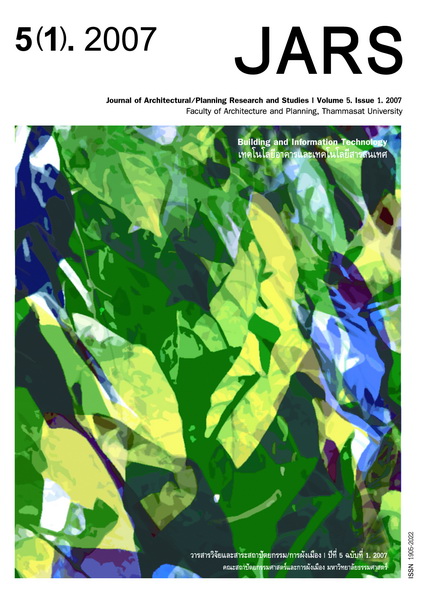Establishing Energy Consumption Benchmarks of Office Buildings in Bangkok
Main Article Content
Abstract
This paper presents energy consumption benchmarks of office buildings based on the local context
of Bangkok in terms of kWh/m2/month and kWh/m2/year. The benchmark is important as a starting point
of systematic energy management in office buildings. It has potential to identify energy performance of an
office building by comparing against others. If the building performs lower than the standard, the benchmark
offers a realistic energy goal. Then systematic energy management—establishing action plan, implementing
strategies, monitoring energy consumption and continuous improvement—can be continued.
Downloads
Article Details

This work is licensed under a Creative Commons Attribution-NonCommercial-NoDerivatives 4.0 International License.
All material is licensed under the terms of the Creative Commons Attribution 4.0 International (CC-BY-NC-ND 4.0) License, unless otherwise stated. As such, authors are free to share, copy, and redistribute the material in any medium or format. The authors must give appropriate credit, provide a link to the license, and indicate if changes were made. The authors may do so in any reasonable manner, but not in any way that suggests the licensor endorses you or your use. The authors may not use the material for commercial purposes. If the authors remix, transform, or build upon the material, they may not distribute the modified material, unless permission is obtained from JARS. Final, accepted versions of the paper may be posted on third party repositories, provided appropriate acknowledgement to the original source is clearly noted.
References
UK Building Research Establishment. (2000). Energy consumption guide 19: Energy use in offices. Watford, UK.
Electrical and Mechanical Services Department of Hong Kong. (2006). Energy consumption indicators and benchmarks for commercial sector. Retrieved March 27, 2007, from http:// www.hkiol.org/energy2/ main.html
National University of Singapore and the Building and Construction Authority of Singapore. (2006). E-energy benchmark system. Retrieved March 27, 2007, from http://www.bdg.nus.edu.sg/building energy/e_energy/index.html
Day, A. R., Maidment, G. G., & Ratcliffe, M. S. (2000). Cooling degree-day and their applicability to building energy estimation. Proceedings of CIBSE/ASHRAE Conference. Dublin, Treland.
Dong, B., Lee, S. E., & Haji-Sapar, M. (2005). A holistic utility bill analysis method for baslining whole commercial building energy consumption in Singapore. Energy and Buildings, 37, 167-174.
Capehart, B. L., Turner, W. C., & Kennedy, W. J. (2003). Guide to energy management (4th ed.). Lilburn, GA: Fairmont press.
Deng, S. M., & Burnett, J. (2000). A study of energy performance of hotel buildings in Hong Kong. Energy and Buildings, 31, 7-12.
BBC weather. (2006). Average conditions of Bangkok. Retrieved March 27, 2007, from http:// www.bbc.co. uk/weather/world/city_guides/results.shtml?tt=TT002890
BBC weather. (2006). Average conditions of Singapore. Retrieved March 27, 2007, from http://www.bbc.co. uk/weather/world/city_guides/results.shtml?tt=TT002780
BBC weather. (2006). Average conditions of Hong Kong. Retrieved March 27, 2007, from http://www.bbc.co. uk/weather/world/city_guides/results.shtml?tt=TT002190
BBC weather. (2006). Average conditions of London. Retrieved March 27, 2007, from http://www.bbc.co. uk/weather/world/city_guides/results.shtml?tt=TT003790


